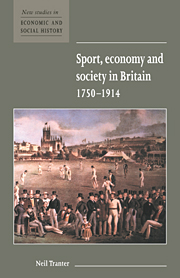2 - Growth or decline? The initial impact of urban industrialisation
Published online by Cambridge University Press: 18 December 2009
Summary
Of the many controversial issues that have emerged from the recent burgeoning of academic interest in the history of sport in Britain, one of the most enduring has concerned the effect of economic and demographic change on the extent of sporting activity among the working classes in the period between the late eighteenth and mid-nineteenth centuries. Writing at a time when it was fashionable to regard this period as one of revolutionary economic and demographic development, the earliest academic historians of sport were generally agreed that the initial impact of urban industrialisation and population growth on popular sport was detrimental. Most forcibly expressed by Robert Malcolmson, the belief that a once thriving mass sporting culture began to decline during the later decades of the eighteenth century and had largely disappeared by the onset of the Victorian era was shared by all (Malcolmson, 1973: 118–57; Dunning, 1975: 112; Walvin, 1978: 2–3; Dunning and Sheard, 1979: 40–1).
Fundamental to this decline, it was argued, was a multiplicity of factors which, on the one hand, diminished the willingness and ability of working-class people themselves to participate in sport and, on the other, eroded that active, or at least passive, support of the social elite which was assumed to be crucial to the existence of a buoyant mass sporting culture. For some working-class men, imbued with a growing desire for respectability and increasingly disenchanted by their dependence on the paternalism of their social superiors, the decision to abandon customary sporting practices was seen to have been largely self-determined. For most, however, it was explained as an unwanted but unavoidable consequence of what was assumed to be a rapidly changing environment.
- Type
- Chapter
- Information
- Sport, Economy and Society in Britain 1750–1914 , pp. 3 - 12Publisher: Cambridge University PressPrint publication year: 1998



